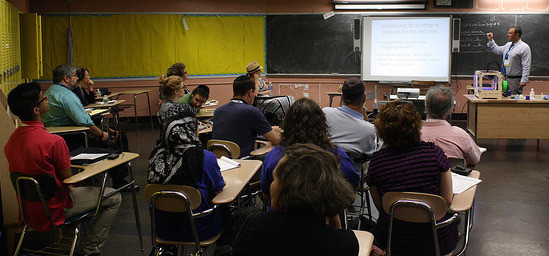GothamTalks: Commentary from New York civic leaders

Gotham Gazette and New Leaders Council -- a nonpartisan, nonprofit leadership institute -- have partnered with Manhattan Neighborhood Network to create a series of video commentaries by New York City civic activists. GothamTalks is short video essays submitted through the New Leaders Council alumni network, which consists of hundreds of New Yorkers working in advocacy, government, campaigns, nonprofits, business, law, and other aspects of city life.
Like both the reporting we do at Gotham Gazette and the written op-ed columns we publish, the GothamTalks video commentaries range in subject, but are all meant to move the public discussion forward. Please watch, listen, and let us know what you think. Use #GothamTalks on social media, and tag us @GothamGazette and @NLC_NYC.
Note: The views expressed in GothamTalks are entirely those of the commentators, and not of Gotham Gazette or New Leaders Council.
************
March 14, 2018
Jordan Stockdale
Gentrification, and What To Do If You're a Gentrifier
March 12, 2018
Michael Pernick
Campaign Finance Reform
March 1, 2018
Crystal Hudson
Fighting Alzheimer's Disease & Supporting Caregivers of Those Suffering
November 17
Jarret Berg
Voting rights and election integrity
November 10, 2017
Elizabeth Adams
Getting involved locally
November 3, 2017
Max Markham
Voting in Local Elections
Enhancing City Efforts to Move Individuals from Homelessness to Homes

new tenants (photo via Ed Reed/Mayor's Office)
Amid this National Hunger and Homelessness Awareness Week, as organizations across the country bring attention to the issues of hunger and homelessness, it’s important to also bring attention to and advocate for thoughtful policy solutions that address the gaps in our current efforts. On homelessness, it is essential that we provide landlords and formerly homeless tenants the support they need to both encourage landlords to rent to people without stable housing and address tenancy issues as they arise instead of amid the emergency of homelessness.
According to the City’s Turning the Tide on Homelessness in New York City, as of February, the de Blasio Administration had helped 51,500 individuals move from homeless shelters to housing or keep their housing under the threat of homelessness. This is a striking number when considered in the context of current homelessness numbers, illustrating the extent of our housing affordability crisis. Despite preventing or ending homelessness for tens of thousands of New Yorkers, there remains a crisis. At best, city homelessness has only stabilized, if you consider Furman Center analysis that the 2 percent increase in the city shelter census from 2015-16 is the lowest yearly increase since 2011.
Amid our difficult housing market, the City must do even more to turn the tide on moving individuals from shelter to permanent housing and keeping them housed. Paramount is enhancing landlord engagement. As Turning the Tide notes, landlords are “key partners” in the “continued success” of rental subsidy programs and moving individuals from shelter to home.
To an extent, the City engages landlords in housing those experiencing homelessness. It offers landlords signing bonuses and security deposits to mitigate the perceived risks of renting to those with City rental subsidies. It will also provide a 2 percent rent escalator for new scattered-site supportive housing units to incentivize landlords to provide units. (The City’s “NYC 15/15” program aims to build 15,000 units of supportive housing, permanent housing that includes social services, over 15 years.)
The City also engages landlords in housing the homeless through its public-private partnerships. For example, the Come Home NYC program with Enterprise Community Partners, engages landlords in permanently housing homeless families with income. Enterprise recruited landlords to provide apartments, offering participating landlords a guarantee of up to $3,000 per lease to offset costs like missed rent and legal fees.
Financial incentives are an important carrot to spur landlords to rent to people experiencing homelessness. Concerns and stigmas about renting to this population exist, even if unfounded. For its Home No Less Will Do Campaign, homeless charity Crisis UK researched landlord attitudes on renting to homeless people, surveying nearly 1,000 landlords and interviewing landlords and landlord organizations. It found 82 percent of surveyed landlords unwilling to rent to this population due to a perceived greater risk of rent arrears and intensive tenancy management; and when renting to the homeless, 18 percent increased the security deposit and 16 percent increased rent.
But New York City should engage landlords with more than financial incentives. For example, offer landlords other carrots to encourage them to rent to those with City rental subsidies or Section 8 vouchers. One useful tool is a named contact for the landlord to utilize in the event of tenancy issues. In another Crisis UK survey, a majority of landlords stated that having a named contact, in addition to direct rental payments and guaranteed funds, would incentivize them to rent to homeless people. Also according to Crisis’ anecdotal evidence from a tenancy support program, landlords appreciate having the consistent tenancy support of reputable nonprofit providers when renting to these prospective tenants.
One example the City should consider is the City of Boston’s recently launched Landlord Guarantee Pilot Program. The program is based on a national model to address homelessness in cities with rental markets like New York City - very competitive with extremely low vacancy rates. It has been successful in Seattle and Portland, and New York City should consider it.
Like New York City’s current landlord engagement, the Boston program offers landlords financial incentives such as access to funds for losses like unpaid rent and apartment damages. In addition, it offers landlords other incentives to rent to those with a housing subsidy. One is a landlord partner who supports the landlord-tenant relationship. Another is access to landlord resources such as free mediation services. A landlord partner and landlord resources address landlords’ perceived risks in renting to people experiencing homelessness. Importantly, they also switch the emphasis from acting in a crisis to maintaining tenancy, assisting landlords with resolving issues that could derail the tenancy, before they rise to eviction and homelessness.
As the impact of City efforts to move individuals from homelessness to housing demonstrates, we need to do more to really impact, prevent, and reduce homelessness. This means looking outside the traditional boundaries we work within in New York City. We cannot build our way out of homelessness. We also cannot repeat the mistakes of the past. Ending homelessness requires various sectors working together in partnership.
***
Nicole Bramstedt is the Director of Policy at Urban Pathways, a nonprofit social services and supportive housing organization serving homeless adults. On Twitter at @UrbanPathwaysNY.
***
Have an op-ed idea or submission for Gotham Gazette? Email This email address is being protected from spambots. You need JavaScript enabled to view it.
The Dangerous Gutting of ESL Instruction Must Be Reversed

(photo via NYC Schools on flickr)
High school can be rough. Our children and students are frequently insecure, uncertain, and grasping to find their way in a new and unfamiliar environment. Some students have to deal with not only that, but also the fact that they don’t speak English.
For most English Language Learners (ELLs), one safe haven has been their English classroom, where a teacher understood their special needs and made sure no one made fun of their inevitable errors and struggles with a new language. But the most recent revision of Commissioner's Regulation Part 154, which governs how English as a second language (ESL) instruction is distributed, has largely withdrawn that support system. For example, beginning ELLs who formerly took three classes daily in direct English instruction may now have as few as one.
Instead of ESL classes, New York State purports to blend English instruction into other courses. For example, in the daily 40 minutes that an United States-born student has to study, say, the Civil War, ELLs are expected to study both the Civil War and English. So not only do they get less English instruction, but they also get less instruction in history than native speakers. Principals may see it as a win-win. They can dump ESL classes, add nothing, save money, and hope for the best.
I don’t know about you, but if I went to China tomorrow, I’d want intense instruction in Mandarin or Cantonese before I ever attempted opening a history book. I want the best for my students, and that includes as much English instruction as possible. Expecting children to master history before being able to order a pizza or even introduce themselves is remarkably short-sighted, reflecting total ignorance of language acquisition.
I know a Spanish teacher, dual-licensed in ESL, whose principal asked her if she minded the school using her class to grant ESL credit to students. Can you imagine newcomers studying Spanish and getting credit for English? Any administrator who thinks you learn English in a Spanish class may need to rethink their own accreditation. And any administrator who cynically places ELLs in situations where they won’t learn English needs to find a more suitable line of work.
A friend teaches social studies in Brooklyn. In his class, currently oversized with 41 students, he has several ELLs. There is an ESL teacher who comes in Tuesdays and Thursdays, and New York State says they are therefore getting English instruction. I have no idea how. My friend says the class is completely incomprehensible to the students. Yet there they sit, and twice a week an ESL teacher sits in the same room. According to New York State, they are therefore learning English.
This is personal for me. I’m an ESL teacher. I have gifted young colleagues in danger of losing their positions for no good reason. Under Part 154, any subject teacher can take 12 credits, teach any subject whatsoever, and have New York State assert her students are concurrently learning English. That’s magical thinking. Learning a language is an intense experience for both student and teacher. It’s inconceivable to me that ELLs will acquire not only English, but also an academic subject in the same time native English speakers acquire the subject matter alone.
We’ve finally moved on from Regents Chancellor Merryl Tisch and her particular embrace of corporate education reform. It’s time for her esteemed successor, Betty Rosa, to embrace policies that support the most vulnerable among us. In the Trump era, my students have enough to worry about.
ELLs don’t need backward, baseless policies that deprive them of fundamental support in order to save a few bucks. The city and state teachers unions, UFT and NYSUT, have resolved that newcomers need more instruction in English, not less. That’s common sense. It’s time for the Regents to awaken from their slumber and follow our lead.
***
Arthur Goldstein is an ESL teacher and UFT chapter leader for Francis Lewis High School. On Twitter @TeacherArthurG.
***
Have an op-ed idea or submission for Gotham Gazette? Email This email address is being protected from spambots. You need JavaScript enabled to view it.




